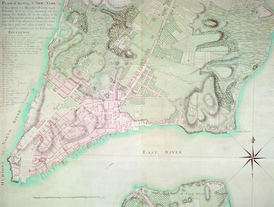Land of the Blacks
In the hills and swamps that stretched across Manhattan Island one mile north of New Amsterdam, both free and enslaved blacks began to clear the tangle of trees, vines, and shrubs to build their own homes and plant their own gardens. The time was 1643, and the area would soon be called the Land of the Blacks.
The black settlement began during the Dutch wars with neighboring Indians. When raids began, the white settlers fled to the safety of New Amsterdam. Director-General Willem Kieft decided to replace the white settlers with black ones, as a buffer for the community. The first land grants were given to members of the black militia such as Domingo Anthony and “Captain of the Blacks” Manuel Trumpeter, or their widows, such as Catalina Anthony. The grants were sizeable, from eight to twelve acres each, enough land for a garden, crops, and pasture for their cattle, goats, and sheep. Orchards were planted and included trees of apples, peaches, plums, and cherries. The homes and barns were mostly wooden with roofs of thatch or board.
Many of those who gained land grants were elders who had won a status we know as half-freedom, but their children remained enslaved. Nevertheless, the farms were passed down through the generations, creating a strong black community that petitioned for their rights, married, baptized their children and, at least a century before the Underground Railroad, harbored runaways.
This entry contributed by
Curriculum Concepts International
Related Media
Images

|
Minetta Lane is a remnant of a road, later called the Negroes’ Causeway, that ran alongside Minetta Creek and connected some of the African farms with New Amsterdam.
|

|
The Land of the Blacks included parts of Chinatown, Little Italy, SoHo, and Greenwich Village. Washington Square Park (pictured) includes land once owned by five Africans.
|
